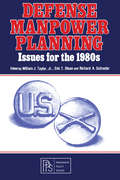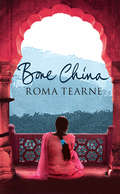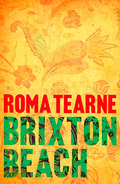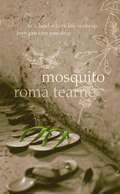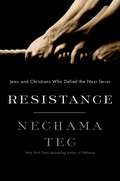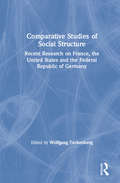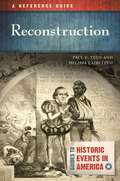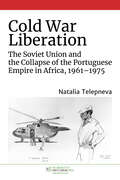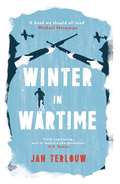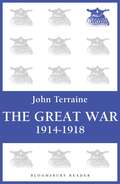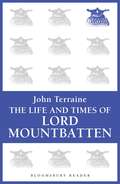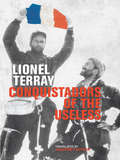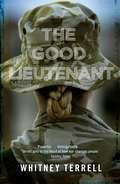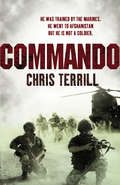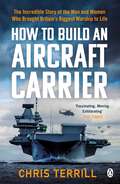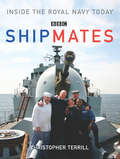- Table View
- List View
Storm and Conquest: The Battle for the Indian Ocean, 1808-10
by Stephen TaylorThe Indian Ocean, 1809. At stake: Britain's commercial lifeline to India and naval supremacy. In one fatal season, the natural order of maritime power since Trafalgar was destroyed. Storm and Conquest brings together the terrifying ordeal of men, women and children caught at sea in hurricanes, and those who survived to drive the French from the Eastern seas. All shared a need to prove themselves - to make a career, or a fortune, or a marriage - in places which could be at once magnificent and terrifying.
The Advent of the All-Volunteer Force: Protecting Free Society (Critical Moments in American History)
by William A. TaylorThis book examines the extensive influence of the All-Volunteer Force (AVF) on the past, present, and future of America, demonstrating how the AVF encompasses the most significant issues of military history and defense policy. Throughout the vast majority of its wars during the twentieth century, the United States relied on a mixture of volunteers who chose to serve and conscripts provided through the Selective Service System, known colloquially as the draft. When the United States emerged as a world superpower in the aftermath of World War II, U.S. policymakers also depended on the draft during peacetime. Drawing on primary source documents, this book guides readers through the transition from the draft to the AVF and analyzes its history, results, challenges, and implications. Each chapter provides an overview of the issues of the time, recounts the ensuing debates and developments around them, and examines how they manifested themselves relative to the advent of the AVF and American society during times of peace and war. Combining narrative with documents, The Advent of the All-Volunteer Force is a valuable resource for students, scholars, policymakers, and general readers interested in modern American history, military history, and the dynamic linkages between policy, politics, and American society.
The Advent of the All-Volunteer Force: Protecting Free Society (Critical Moments in American History)
by William A. TaylorThis book examines the extensive influence of the All-Volunteer Force (AVF) on the past, present, and future of America, demonstrating how the AVF encompasses the most significant issues of military history and defense policy. Throughout the vast majority of its wars during the twentieth century, the United States relied on a mixture of volunteers who chose to serve and conscripts provided through the Selective Service System, known colloquially as the draft. When the United States emerged as a world superpower in the aftermath of World War II, U.S. policymakers also depended on the draft during peacetime. Drawing on primary source documents, this book guides readers through the transition from the draft to the AVF and analyzes its history, results, challenges, and implications. Each chapter provides an overview of the issues of the time, recounts the ensuing debates and developments around them, and examines how they manifested themselves relative to the advent of the AVF and American society during times of peace and war. Combining narrative with documents, The Advent of the All-Volunteer Force is a valuable resource for students, scholars, policymakers, and general readers interested in modern American history, military history, and the dynamic linkages between policy, politics, and American society.
Defense Manpower Planning: Issues for the 1980s
by William J. Taylor Eric T. Olson Richard A. SchraderDefense Manpower Planning discusses the important set of national security issues related to defense manpower for the 1980s. The topics in the text focus on the problems of manpower acquisition and retention. The historical background and description of the military power during the 1970s and 1980s are given in detail. A military manpower chronology is provided. The book enumerates some of the manpower issues and debates. Such salient issues as the quantity, quality, socio-economic factors, and the issue of cost, combat effectiveness, and readiness factors are carefully considered. After listing the issues, solutions are then presented. The variants of the all-volunteer force, of conscription, and combining volunteers and conscripts are suggested. A part of the book focuses on active duty forces. The issue of employing women in the military is fully addressed. A description of combat is also tackled. A section of the text explains the relationship between precision guided munitions and the volunteer force. The book will provide useful information to defense military planners, historians, and students of history.
Bone China
by Roma TearneAn epic novel of love, loss and a family uprooted, set in the contrasting landscapes of war-torn Sri Lanka and immigrant London.
Brixton Beach (Romans, Nouvelles, Recits (domaine Etranger) Ser. #Vol. 6150031)
by Roma TearneOpening dramatically with the horrors of the 2005 London bombings, this is the profoundly moving story of a country on the brink of civil war and a child's struggle to come to terms with loss.
Mosquito
by Roma TearneA lyrical and profoundly moving story of love, loss and civil war, set in Sri Lanka, London and Venice.
Resistance: Jews and Christians Who Defied the Nazi Terror
by Nechama TecNechama Tec's Defiance, an account of a Jewish partisan unit that fought the Nazis in the Polish forests during World War II, was turned into a major feature film. Yet despite the attention this film brought to the topic of Jewish resistance, Tec, who speaks widely about the Holocaust and the experience of Jews in wartime Poland, still ran into the same question again and again: Why didn't Jews fight back? To Tec, this question suggested that Jews were somehow complicit in their own extermination. Despite works by Tec and others, the stereotype of Jewish passivity in the Holocaust persists. In Resistance, Tec draws on first-hand accounts, interviews, and other sources to reveal the full range of tactics employed to resist the Nazi regime in Poland. She compares Jewish and non-Jewish groups, showing that they faced vastly different conditions. The Jewish resistance had its own particular aims, especially the recovery of dignity and the salvation of lives. Tec explores the conditions necessary for resistance, including favorable topography, a supply of arms, and effective leadership, and dedicates the majority of the book to the stories of those who stood up and fought back in any way that they could. Emphasizing the centrality of cooperation to the Jewish and Polish resistance movements of World War II, Tec argues that resistance is more than not submitting--that it requires taking action, and demands cooperation with others. Whereas resilience is individual in orientation, Tec writes, resistance assumes others. Within this context, Tec explores life in the ghettoes, the organizations that arose within them, and the famous uprising in Warsaw that began on January 18, 1943. She tells of those who escaped to hide and fight as partisans in the forests, and considers the crucial role played by women who acted as couriers, carrying messages and supplies between the ghetto and the outside world. Tec also discusses resistance in concentration camps, vividly recounting the Auschwitz-Birkenau camp uprising on October 7, 1944. The refusal of the rebel leaders to give information under unspeakable torture, Tec displays, was just one more of the many forms resistance took. Resistance is a rich book that forever shatters the myth of Jewish passivity in the face of annihilation.
Resistance: Jews and Christians Who Defied the Nazi Terror
by Nechama TecNechama Tec's Defiance, an account of a Jewish partisan unit that fought the Nazis in the Polish forests during World War II, was turned into a major feature film. Yet despite the attention this film brought to the topic of Jewish resistance, Tec, who speaks widely about the Holocaust and the experience of Jews in wartime Poland, still ran into the same question again and again: Why didn't Jews fight back? To Tec, this question suggested that Jews were somehow complicit in their own extermination. Despite works by Tec and others, the stereotype of Jewish passivity in the Holocaust persists. In Resistance, Tec draws on first-hand accounts, interviews, and other sources to reveal the full range of tactics employed to resist the Nazi regime in Poland. She compares Jewish and non-Jewish groups, showing that they faced vastly different conditions. The Jewish resistance had its own particular aims, especially the recovery of dignity and the salvation of lives. Tec explores the conditions necessary for resistance, including favorable topography, a supply of arms, and effective leadership, and dedicates the majority of the book to the stories of those who stood up and fought back in any way that they could. Emphasizing the centrality of cooperation to the Jewish and Polish resistance movements of World War II, Tec argues that resistance is more than not submitting--that it requires taking action, and demands cooperation with others. Whereas resilience is individual in orientation, Tec writes, resistance assumes others. Within this context, Tec explores life in the ghettoes, the organizations that arose within them, and the famous uprising in Warsaw that began on January 18, 1943. She tells of those who escaped to hide and fight as partisans in the forests, and considers the crucial role played by women who acted as couriers, carrying messages and supplies between the ghetto and the outside world. Tec also discusses resistance in concentration camps, vividly recounting the Auschwitz-Birkenau camp uprising on October 7, 1944. The refusal of the rebel leaders to give information under unspeakable torture, Tec displays, was just one more of the many forms resistance took. Resistance is a rich book that forever shatters the myth of Jewish passivity in the face of annihilation.
Comparative Studies of Social Structure: Recent German Research on France, the United States and the Federal Republic
by Wolfgang TeckenbergA collection of essays with the purpose of stimulate interest and provoke discussion and criticism, and so contributing to our understanding of the three very different societies of France, the USA and Germany. Each essay stands on its own, and it is the authors’ intention to explain some of the differences between Germany and the United States in the first article. The second essay suggests that career mobility in France has more in common with social mobility in the United States than in Germany. The third essay, while not an explicitly comparative analysis, was included because it clearly shows the close links between the educational and occupational systems in Germany, a source of major differences with the United States, at least until the 1980s. The last section contains analyses of income attainment. Drawing on studies in the United States conducted by Erik O. Wright, the fourth essay compares the effects of education and position on income attainment. Since these can be construed as class effects, we were also curious about other types of potential positional and nonvertical income differences in a comparison of France, the United States, and the Federal Republic of Germany (the fifth essay). The concluding summary is very brief, giving only preliminary answers to the more detailed questions raised in the comparative empirical research projects.
Comparative Studies of Social Structure: Recent German Research on France, the United States and the Federal Republic
by Wolfgang TeckenbergA collection of essays with the purpose of stimulate interest and provoke discussion and criticism, and so contributing to our understanding of the three very different societies of France, the USA and Germany. Each essay stands on its own, and it is the authors’ intention to explain some of the differences between Germany and the United States in the first article. The second essay suggests that career mobility in France has more in common with social mobility in the United States than in Germany. The third essay, while not an explicitly comparative analysis, was included because it clearly shows the close links between the educational and occupational systems in Germany, a source of major differences with the United States, at least until the 1980s. The last section contains analyses of income attainment. Drawing on studies in the United States conducted by Erik O. Wright, the fourth essay compares the effects of education and position on income attainment. Since these can be construed as class effects, we were also curious about other types of potential positional and nonvertical income differences in a comparison of France, the United States, and the Federal Republic of Germany (the fifth essay). The concluding summary is very brief, giving only preliminary answers to the more detailed questions raised in the comparative empirical research projects.
Reconstruction: A Reference Guide (Guides to Historic Events in America)
by Paul E. Teed Melissa Ladd TeedProviding an exciting narrative of Reconstruction based on current scholarship, historical sources, as well as interpretive essays on special topics, this book offers real insight into a controversial and critical period in American history.Reconstruction: A Reference Guide covers the entire period of Reconstruction (1863–1877) with a special emphasis on the struggle for social and political equality in the post-Civil War South. The book's analytical essays, selection of primary documents, and biographies of key participants give readers an understanding of social, political, and economic changes that occurred during this important period as well as provide opportunities to explore more specific issues and debates. Synthesizing and building on the work of recent scholars, the book documents how the central struggles of Reconstruction revolved around the meaning of freedom for former slaves. The essays describe how a new and sometimes deadly conflict over equal rights and racial justice raged throughout the South in the post-Civil War period and generated a constitutional crisis in the nation's capital as former slaves created alliances with sympathetic whites and sought to build a biracial democracy in the former Confederacy. Readers will not only understand the facts and events of the period, but will also be introduced to historical sources and key interpretive debates.
Reconstruction: A Reference Guide (Guides to Historic Events in America)
by Paul E. Teed Melissa Ladd TeedProviding an exciting narrative of Reconstruction based on current scholarship, historical sources, as well as interpretive essays on special topics, this book offers real insight into a controversial and critical period in American history.Reconstruction: A Reference Guide covers the entire period of Reconstruction (1863–1877) with a special emphasis on the struggle for social and political equality in the post-Civil War South. The book's analytical essays, selection of primary documents, and biographies of key participants give readers an understanding of social, political, and economic changes that occurred during this important period as well as provide opportunities to explore more specific issues and debates. Synthesizing and building on the work of recent scholars, the book documents how the central struggles of Reconstruction revolved around the meaning of freedom for former slaves. The essays describe how a new and sometimes deadly conflict over equal rights and racial justice raged throughout the South in the post-Civil War period and generated a constitutional crisis in the nation's capital as former slaves created alliances with sympathetic whites and sought to build a biracial democracy in the former Confederacy. Readers will not only understand the facts and events of the period, but will also be introduced to historical sources and key interpretive debates.
The Portuguese at War: From the Nineteenth Century to the Present Day (The Portuguese-Speaking World)
by Nuno TeixeiraFrom war campaigns to peacekeeping operations, The Portuguese at War presents an overview of the conflicts, wars and revolutions in which Portugal was involved from the nineteenth century to the present day. From the French invasions to the civil wars, from the African Empire to the wars of decolonisation, from belligerence in the First World War to neutrality in the Second, from participation in the Atlantic Alliance to peacekeeping operations in Kosovo, East Timor, Lebanon and Afghanistan. The book addresses the military interventions in politics and the role of the countrys political regimes in military reform: from the Liberal Revolutions to the Republic, from the military dictatorship and authoritarian regime to the 25th of April Revolution and the transition to democracy. The historical record of Portugals war involvement is not only closely aligned to international and European circumstance but to internal factors: the economy, society, public opinion and political/military power. A historical perspective must of necessity link Portuguese war excursions with the military institutions in place at the time: their recruitment system, social composition and organisation of the army, navy and air force; the military ethos; the evolution of equipment, weapons and military technologies; strategic military doctrine and how this impacted on tactics and military operations; and of course the war outcomes. Special attention is given to the effects of international isolation after the Estado Novo, and post-Cold War europeanisation. The book does not eschew the plurality of interpretative theories. Rather, it seeks to combine historical accuracy of the Portuguese at war within a highly readable literary narrative aimed not only at undergraduate and research levels, but at a broader public audience interested in the complex reach and role of Portugal in world history.
The Mammoth Book of Special Ops Romance (Mammoth Books)
by Trisha TelepStirring romance featuring the heroes of the Navy SEALs, Delta Force, Air Force Pararescue, the Green Berets, the Army Rangers and other special forces: men and women who live and fight in extreme danger to preserve our freedoms, defenders and protectors of all we hold dear. This collection includes the work of bestselling romance writers such as Shannon K. Butcher and Stephanie Tyler and Larissa Ione, writing as Sydney Croft. Sydney Croft's special forces couple, Annika and Creed, work for the Agency for Covert Rare Operatives (ACRO), all of whose members have special powers, while Shannon K. Butcher's hero is an ex-Navy SEAL. But these fighting men and women have a gentler, protective side; hard-edged weapons when on active duty, they can be caring lovers, of special forces teammates or the civilians they protect.
Cold War Liberation: The Soviet Union and the Collapse of the Portuguese Empire in Africa, 1961–1975 (New Cold War History)
by Natalia TelepnevaCold War Liberation examines the African revolutionaries who led armed struggles in three Portuguese colonies—Angola, Mozambique, and Guinea-Bissau—and their liaisons in Moscow, Prague, East Berlin, and Sofia. By reconstructing a multidimensional story that focuses on both the impact of the Soviet Union on the end of the Portuguese Empire in Africa and the effect of the anticolonial struggles on the Soviet Union, Natalia Telepneva bridges the gap between the narratives of individual anticolonial movements and those of superpower rivalry in sub-Saharan Africa during the Cold War. Drawing on newly available archival sources from Russia and Eastern Europe and interviews with key participants, Telepneva emphasizes the agency of African liberation leaders who enlisted the superpower into their movements via their relationships with middle-ranking members of the Soviet bureaucracy. These administrators had considerable scope to shape policies in the Portuguese colonies which in turn increased the Soviet commitment to decolonization in the wider region. An innovative reinterpretation of the relationships forged between African revolutionaries and the countries of the Warsaw Pact, Cold War Liberation is a bold addition to debates about policy-making in the Global South during the Cold War. We are proud to offer this book in our usual print and ebook formats, plus as an open-access edition available through the Sustainable History Monograph Project.
Cold War Liberation: The Soviet Union and the Collapse of the Portuguese Empire in Africa, 1961–1975 (New Cold War History)
by Natalia TelepnevaCold War Liberation examines the African revolutionaries who led armed struggles in three Portuguese colonies—Angola, Mozambique, and Guinea-Bissau—and their liaisons in Moscow, Prague, East Berlin, and Sofia. By reconstructing a multidimensional story that focuses on both the impact of the Soviet Union on the end of the Portuguese Empire in Africa and the effect of the anticolonial struggles on the Soviet Union, Natalia Telepneva bridges the gap between the narratives of individual anticolonial movements and those of superpower rivalry in sub-Saharan Africa during the Cold War. Drawing on newly available archival sources from Russia and Eastern Europe and interviews with key participants, Telepneva emphasizes the agency of African liberation leaders who enlisted the superpower into their movements via their relationships with middle-ranking members of the Soviet bureaucracy. These administrators had considerable scope to shape policies in the Portuguese colonies which in turn increased the Soviet commitment to decolonization in the wider region. An innovative reinterpretation of the relationships forged between African revolutionaries and the countries of the Warsaw Pact, Cold War Liberation is a bold addition to debates about policy-making in the Global South during the Cold War. We are proud to offer this book in our usual print and ebook formats, plus as an open-access edition available through the Sustainable History Monograph Project.
Winter in Wartime
by Jan TerlouwAn award-winning children's classic. A gripping story about the horrors and dilemmas of warAs the Second World War approaches its end, the Netherlands is still under Nazi control and any acts of resistance are punishable by death.But when fifteen-year-old Michiel is asked to take care of a British Spitfire pilot he doesn’t think twice. He joins the secret struggle against the Nazis, working every day to end the occupation and protect those in danger from it, knowing all the time that spies are everywhere and one loose word could cost him his life…Winter in Wartime is a thrilling, powerful and inspiring adventure story, based on the author’s own experiences as a child in Nazi-occupied Holland.Jan Terlouw was born in the Netherlands in 1931. He worked as a nuclear physicist in countries across the world before entering politics as a representative of the Dutch D66 party in 1971. Alongside his political career he has written many successful children's books, including Winter in Wartime which was based on his own memories of the Nazi occupation. It won the Golden Pen Prize for the best Dutch children's book in 1973 and has since been adapted for film and stage.
The Great War 1914–1918: 1914 - 1918
by John TerraineIt did not need a Fort Sumter cannonade to set the world in flames in 1914, only the pistol shots of an assassin. The Great War 1914-1918, written by one of the leading military historians of his time, John Terrain, thoroughly examines the political, economical and social triggers which led to the eruption of WWI, as well as the progression of the war itself through various campaigns and battles which resulted in the final victory of the Entente Powers. The Great War 1914-1918, first published in 1965, is a brilliant and comprehensive narrative and stands as an authoritative record in its own right.
The Life and Times of Lord Mountbatten
by John TerraineRelive the 20th century through the eyes and words of Lord Mountbatten – a member of the Royal family and one of Britain's most highly decorated naval officers. This extraordinary volume spans 70 years of triumph, conflict and glory in the life of this remarkable man who rose to worldwide recognition as both statesman and military hero, yet was tragically assassinated in 1979.
Conquistadors of the Useless: From the Alps to Annapurna
by Lionel Terray'I have given my whole life to the mountains. Born at the foot of the Alps, I have been a ski champion, a professional guide, an amateur of the greatest climbs in the Alps and a member of eight expeditions to the Andes and the Himalayas. If the word has any meaning at all, I am a mountaineer.' So Terray begins Conquistadors of the Useless- not with arrogance, but with typical commitment. One of the most colourful characters of the mountaineering world, his writing is true to his uncompromising and jubilant love for the mountains. Terray was one of the greatest alpinists of his time, and his autobiography is one of the finest and most important mountaineering books ever written. Climbing with legends Gaston Rébuffat, Maurice Herzog and Louis Lachenal, Terray made first ascents in the Alps, Alaska, the Andes, and the Himalaya. He was at the centre of global mountaineering at a time when Europe was emerging from the shadow of World War II, and he came out a hero. Conquistadors tells of his war-time escapades, of life as an Alpine mountain guide, and of his climbs - including the second ascent of the Eiger North Face and his involvement in the first ever ascent of an 8,000-metre peak, Annapurna. His tales capture the energy of French post-war optimism, a time when France needed to re-assert herself and when climbing triumphs were more valued than at any other time in history. Terray's death, in the Vercors, robbed mountaineering of one of its most passionate and far-sighted figures. His energy, so obvious in Conquistadors of the Useless, will inspire for generations to come. A mountaineering classic.
The Good Lieutenant
by Whitney TerrellWhitney Terrell's remarkable novel of the Iraq War, The Good Lieutenant, literally starts with a bang, as an operation led by Lieutenant Emma Fowler goes spectacularly wrong. Men are dead - one, a young Iraqi, by her hand. Others of the casualties were soldiers in her platoon. And the signals officer, Dixon Pulowski. Pulowski is another story entirely - Fowler and Pulowski have been lovers since they first met at Fort Riley in Kansas . . . From this conflagration, The Good Lieutenant unspools backward in time as Fowler and her platoon are guided into disaster by suspect informants and questionable intelligence, their very mission the consequence of a previous snafu in which an American soldier had been kidnapped by insurgents. We hear the voice of Lieutenant Fowler but also those of jaded career soldiers and Iraqis both innocent and not so innocent. Ultimately, as all these stories unravel, Terrell reveals what can happen when good intentions destroy, experience distorts, and survival becomes everything.
Commando
by Chris TerrillChris Terrill is a man in search of his limit. He's 55 years old. He is not a soldier. He is being trained by the Royal Marines and he is going to Afghanistan. The only difference is that instead of a gun, Chris will be holding a camera and filming the whole ordeal for a major TV series.The Royal Marines Commando training base in Lympstone Devon, has a famous motto: '99.9% need not apply'. Of those who start training, after a very tough selection process, nearly 50% fail to make it through the most gruelling physical tests of any armed forces in the world in an eight month training regime. The elite who do eventually pass out are generally eighteen years old and at the peak of physical condition. But Chris Terrill is the exception: this book will tell of his heroic struggle to become the oldest man to win the coveted Royal Marines Commando Green Beret and enter the record books.And after six months of hell, what next? Chris will follow the raw recruits on a tour to Southern Afghanistan. He will tell the story in book and film of the fears and hopes of the youngsters as they are plunged into one of the planet's most dangerous wars in the outlaw mountain terrain of Helmand Province. He will tell of ferocious battles against the Taliban, of firefights, of jaw-dropping heroism, British sang froid and humour and tragedy as causalities are suffered -- all from the unique perspective of a civilian who has achieved the ultimate accolade: to be accepted as an honorary Royal Marines Commando. Commando is a brilliant account of modern war on the front line.
How to Build an Aircraft Carrier: The Incredible Story of the Men and Women Who Brought Britain’s Biggest Warship to Life
by Chris TerrillThe enthralling story of the HMS Queen Elizabeth, the Royal Navy's largest ever warship"Terrill takes us deep into the bowels of Britain's biggest warship . . . Exhilarating" The Times65,000 tons. 280 metres long. A flight deck the size of sixty tennis courts. A giant piece of Sovereign British territory that's home to up to fifty Aircraft. HMS Queen Elizabeth is the biggest ship in the Royal Navy's history and one of the most ambitious and exacting engineering projects ever undertaken in the UK.But it's her ship's company of 700, alongside an air group of 900 air and ground crew that are Big Lizzie's beating heart. And How to Build an Aircraft Carrier tells their story.From before the first steel of her hull was cut, Chris Terrill has enjoyed unprecedented access to the Queen Elizabeth and the men and women who have brought her to life. From Jerry Kyd, the ship's inspirational captain, to Cdr Nathan Gray, the first pilot to land Britain's new stealth jet fighter on her deck, Terrill has won the trust and confidence of the ship's people.How to Build an Aircraft Carrier tells the story of Britain at its best: innovative, confident, outward-looking and world-beating.
Shipmates
by Chris TerrillThis is the tie-in book to a two part BBC 1 documentary series to be screened at 9.00pm in October and which will end on the bicentenary of the Battle of Trafalgar on 21st October. Chris Terrill is famous for his fly on the wall documentaries which have been watched by millions and received wide critical acclaim. We have had HMS Brilliant and The Cruise (audience reached 11 million). Chris has based himself for the last few months in the very heart of the modern day naval experience. We will see: a Royal Naval Chaplain exorcising a haunted barracks in Portsmouth, a vodka-fuelled Trafalgar Day celebration in the British Embassy in the Moscow in 2004, a Polaris submarine crossing the Atlantic on an exercise in which it will 'pretend' to nuke America, the patrol of the frigate HMS Chatham in the Gulf, suddenly diverted to Sri Lanka after the Tsunami and the Fleet Review, where HMS Chatham in honour of her humanitarian role in Asia, will lead the entire assembly of a hundred warships, British and foreign, down the Solent. Chris is the only film maker to be granted exclusive, behind the scenes access by the Navy this year. During the filming Chris will capture the heart and soul of the sailors aboard, and on shore: there will be plenty of irreverence, practical jokes and laughs, and the human reality of the families left behind for months on end as warships and submarines go on extended tours of duty. This will be the fullest ever account of the Modern Navy in a year when the Trafalgar Day celebrations and the Fleet review will attract an avalanche of publicity.


